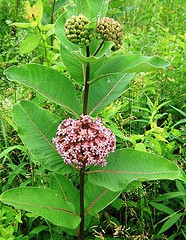Habitat
The Red Milkweed Beetle can be found in one common place, on the
underside of the Milkweed plant leaf. They usually live and feed in
small groups, so it is rare to find a single beetle on a leaf
feeding. This beetle can be found basically anywhere the plant is
present, such as alongside a road, in a large field of milkweed or
in a personal garden containing milkweed. Visit
this page to learn more about the common milkweed plant, its
habitat, and other interesting facts! The peak hatching season
for the nymph milkweed beetle is between June and August and is
prevalent anywhere from Canada to Costa Rica (BugGuide, 2003). The nymph
larvae of the Red Milkweed Beetle requires roughly an 80 degree
fahrenheit environment in order to hatch, where it begins the many
molting stages it undergoes (My Monarch Guide, n.d.). 
This organism is colored brightly as a warning sign to its predators, in turn protecting itself from being consumed. This specific characteristic is advantageous for the beetles due to the fact that it deters themselves from predation. Many different organisms live in the same environment that pose a threat to the beetle such as wasps, praying mantises, or spiders. This method of protection leads to a better survival rate for the beetle population, in turn letting the beetle expand its population (The Natural Web, 2013). Visit this page to learn more about the Monarch Butterfly, another organism that is unaffected by the cardiac glycosides within the milkweed plant!
This beetle could either be considered either a menace or merely an interruption to some gardens owners. It is said that if milkweed is a host in the garden, then the beetle is considered a major problem due to the infestation of “sap suckers.” The easiest way to get rid of these insects one may ask, just with a simple squish (My Monarch Guide, n.d.).
This organism does indeed have an impact on the environment. Due to their ability to tolerate the glycosides within the milkweed plant, they in turn are able to keep the population of the plant at a constant and steady population. There is no negative impact on the environment, unless one was specifically growing milkweed plants (Milkweed Bug, 1997).
There is scientific evidence supporting the fact that distance between patches of milkweed and beetle mortality are directly correlated. The study we specifically looked into showed that the closer together the milkweed plants are, the lower the “migration mortality” is. This particular study also investigated the impact of habitat segregation and the impact it has on any ecosystem or organism, not just the Red Milkweed Beetle (Matter, 2006).
Emigration rate has been tested across both male and female beetles.
It has been proven that the female sex as well as beetle density in
fact does not influence emigration rate among beetle populations,
but rather the fitness of males within the beetle population is
correlated with sex and emigration rate. The males rate of
emigration was actually correlated with flight frequency as well as
how likely mating was to take place in the specific location
(Lawrence, 1987).
Please visit the Form and Function page next!